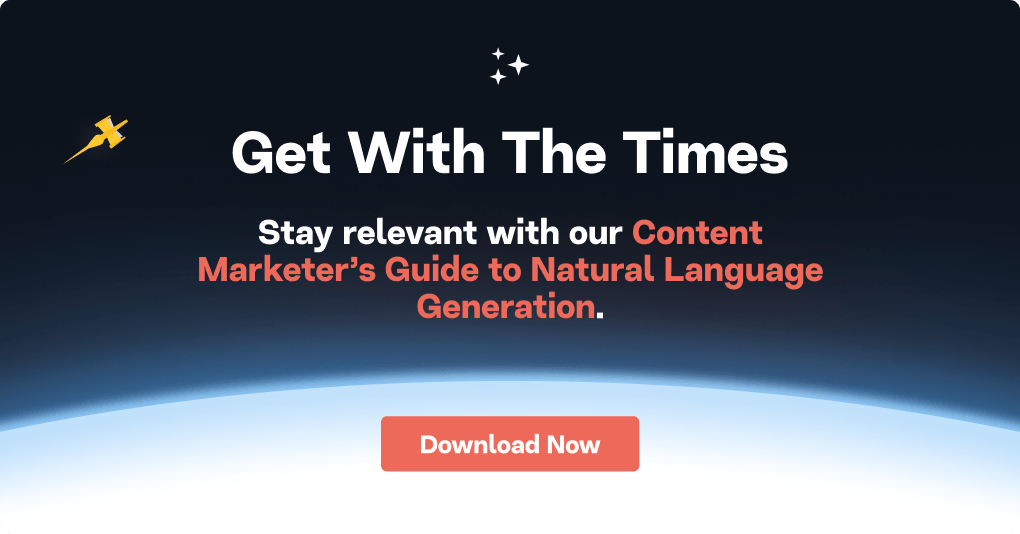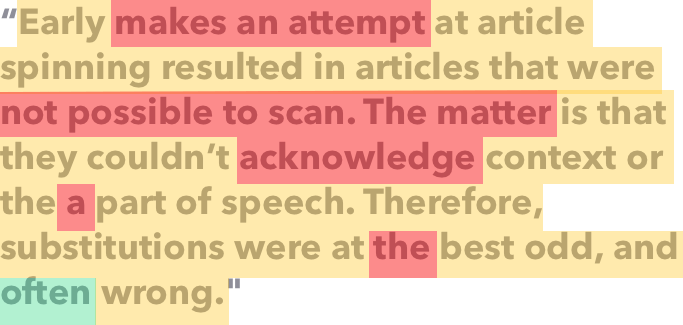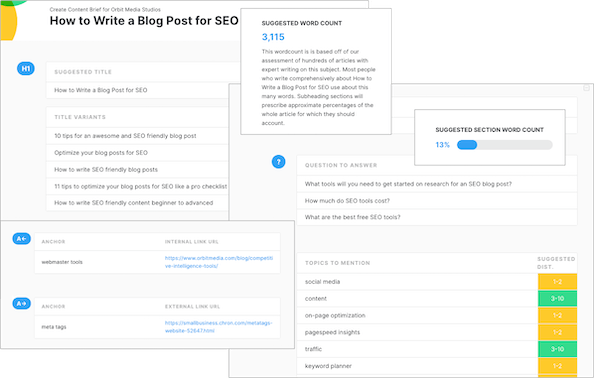Natural Language Generation vs. Article Spinning
Natural language generation uses deep learning to create human-like readable text; a unique article based on a language prediction model. Article spinner tools take an original article and produce one or more variations by replacing specific words, phrases, or sentences with alternate versions.
If you’ve done any research on natural language generation applications for content marketing, you may have come across article spinning software. Also known as article rewriting, it’s one of those old SEO tactics, like automated backlinking, used for less-than-legitimate (blackhat) purposes.
In this post, we look at how spinning software works, their use case, and how it differs from natural language generation (NLG). There are many reasons why I don’t condone the use of article spinners, so think of this article as a public service announcement.

How Are Article Spinners Used
The best way to understand articles spinners is by looking at the language used to market these products. Here are a few quotes from sites trying to sell spinner software:
- “Instantly spin unique versions of any articles.”
- “Generate hundreds of new articles in minutes.”
- “Churn out mountains of content.”
- “Creating huge amounts of content to help better rank your sites.”
Some even try to capitalize on the artificial intelligence trend by claiming their software is AI-driven. They describe their product using AI terms and sometimes even resort to making up terms.
“Emulated natural language” has to be my favorite fake term. I kid you not. Somebody made it up, but it wasn’t me! It sounds elaborate but means nothing.
Based on the language used, you can probably guess the type of situation in which article spinners are deployed. Typically they’re used in low-quality sites strictly created for SEO purposes while keeping article writing costs as low as possible.
Creating readable text is low on the priority list for these types of blogs. Instead, their purpose is to create a linking network to boost the ranking of the main “money” site.
Publishing quality content is not the object of this endeavor. “Unique content” is whatever is good enough to pass automated search engine plagiarism checks.
If you’re wondering whether the world wide web really needs more of this content, the answer is no!
How Does an Article Spinner Work?
Compared to NLG, content spinners are primitive. They take a piece of content and create a variation in an attempt to make it appear as though it’s a unique article. This is accomplished by replacing words, phrases, sentences, and occasionally paragraphs with variants.
Early attempts at article spinning resulted in articles that were impossible to read. The problem is that they couldn’t recognize context or the part of speech.
Therefore, substitutions were at best odd, and frequently wrong. The content certainly wasn’t original.
Here’s the exact output from an article spinner using the previous paragraph as an example.

Duplicate content is colored yellow. Poor substitutions are colored red. Acceptable substitutions are colored green.
So, 67.5% of the spun article is duplicate content that hasn’t changed from the original. Six out of seven substitutions were of poor quality and only one was acceptable.
Need I say more!
Poor-quality derivative content is the hallmark of article spinning.
Although some newer article spinners claim to employ artificial intelligence, that’s really stretching things a bit far. At best, they may be using Google’s Natural Language API to extract tokens and sentences, and for part-of-speech (PoS) tagging. That is part of natural language processing (NLP), but as we’ll see, a lot more is required for natural language generation.
No matter how you look at, article spinning still remains a process of generating derivative works from an original.
Paraphrasing Tools Don’t Paraphrase
Given the negative connotation of article spinning, some article spinner tools have branded themselves as a paraphrasing tool. Don’t be fooled. The paraphrase tools I have seen operate exactly in the manner of article spinners.
See for yourself.

The output above is from a free paraphrasing tool where I used the same original text from the previous section. The highlighted text indicates words that have been substituted.
I ran both the original and the paraphrased version through Grammarly; you can see the result below.
Using this “paraphrasing” tool results in a loss of clarity and engagement. That’s exactly opposite of what paraphrasing is suppose to achieve.
How Does Natural Language Generation Work?
Unlike article rewriting, natural language generation doesn’t require an original piece of content. It creates brand new content instead of rewriting existing articles.
NLG takes either a rule-based approach or relies on statistical language modeling. Either method can leverage NLP and natural language understanding (NLU) technologies to improve the quality of the generated text.
NLP analyzes text using (PoS) tagging and entity recognition, while NLU leverages NLP and deep learning to create semantic models that derive a sense of meaning.
The Difference Between NLG and Article Spinning Software
No matter how advanced article spinners may claim to be, they cannot generate text but only change it. This type of tool requires an existing blog post from which it can only produce a derivative.
They do not create, they merely modify. As such, it’s not a good fit for content marketers looking to scale content production and maintain quality without scaling costs and complexity.
The best of that sorry lot may use some limited natural language processing to make better choices when replacing words. But to call it artificial intelligence is a stretch.
How Does MarketMuse NLG Technology Work?
MarketMuse NLG Technology is an AI-augmented content generation platform whose output is structured by our AI-powered Content Briefs.
MarketMuse NLG Technology produces long-form comprehensive content free from:
Plagiarism
Repetition
Quality Degradation
Each draft is unique, original, and doesn’t simply extract or modify text fragments of other documents. MarketMuse NLG Technology can be configured to match your writers’ styles. It can also emulate the style of an author or publication.
These content briefs that provide structure and substance to the MarketMuse NLG Technology output include:
- A complete structure including subheadings
- Related topics that need to be included
- A list of questions that need to be addressed

This is the same content brief normally given to a human writer from which to work. Instead, we pass it onto MarketMuse NLG Technology.
Think of it this way.
If you were to assign a topic that was unfamiliar to a writer, they would first read up on the subject. MarketMuse NLG Technology is no different. But instead of researching a handful of documents, it goes out to the web to analyze massive amounts of data.
Here’s an excerpt of MarketMuse NLG Technology for the topic “Glucagon as a Non-invasive Diabetic Treatment.”

The subheading, this section’s subject, is “The role of insulin and Glucagon.” Questions and relevant topics associated with this subheading are shown on the right-hand side. Together, these help ensure that the output is relevant and thorough.
Use MarketMuse NLG Technology to:
- Scale content without scaling costs
- Write authoritatively on any topic
- Avoid common pitfalls with AI-generated text
- Emulate whatever writing style you desire
Keep your content costs predictable and your quality consistent by letting AI do the work of providing you with a strong initial draft.
What you should do now
When you’re ready… here are 3 ways we can help you publish better content, faster:
- Book time with MarketMuse Schedule a live demo with one of our strategists to see how MarketMuse can help your team reach their content goals.
- If you’d like to learn how to create better content faster, visit our blog. It’s full of resources to help scale content.
- If you know another marketer who’d enjoy reading this page, share it with them via email, LinkedIn, Twitter, or Facebook.
Stephen leads the content strategy blog for MarketMuse, an AI-powered Content Intelligence and Strategy Platform. You can connect with him on social or his personal blog.
